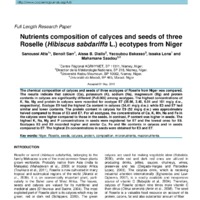Recherche
2 items
Nutrients composition of calyces and seeds of three Roselle (Hibiscus sabdariffa L.) ecotypes from Niger
The chemical composition of calyces and seeds of three ecotypes of Roselle from Niger was compared. The results indicate that calcium (Ca), potassium (K), sodium (Na), magnesium (Mg) and protein contents in calyces are significantly different (P<0.005) among ecotypes. The highest concentrations of K, Na, Mg and protein in calyces were recorded for ecotype E7 (35.66, 3.40, 6.01 and 101 mg/g d.w., respectively). Ecotype E9 had the highest Ca content in calyces (34.41 mg/g d.w.); while E3 and E7 had similar and lower contents. The protein content in calyces for E9 (52 mg/g d.w.) was approximately halved compared to those of E3 and E7. For all ecotypes, the concentrations of Ca, K, Mn, Na and Fe in the calyces were higher compared to those in the seeds. In contrast, P content was higher in seeds. The highest K, Na, Mg and P concentrations in seeds were registered for E7 and the lowest ones for E9. Ecotypes E3 and E9 recorded higher and similar Cu, Fe and Mn contents in calyces and in seeds compared to E7. The highest Zn concentrations in seeds were obtained for E3 and E7.
VARIATION IN MACRO-ELEMENTS AND PROTEIN CONTENTS OF ROSELLE (HIBISCUS SABDARIFFA L.) FROM NIGER
Roselle is an important part of the human diet in many countries, particularly in the Sahel zone of West Africa. The leaves of Roselle are consumed as a green vegetable and in sauce. Nevertheless, little attention has been paid to their nutrient composition at different stages of plant growth. Therefore, an experiment was carried out under rainfall conditions from July to September 2006 at the experimental station of the Agrhymet Regional Centre in Niamey (Niger). The contents of Ca, K, Mg, P and protein in leaves of three ecotypes (A3, A7 and A9) were determined at stages I, II and III, corresponding, respectively to vegetative, flowering and mature stages. The experimental design was a randomized complete block with four replicates and one variable (ecotype). For ecotype A7, the protein content of the leaves decreased significantly (p<0.05) between stage I and II, than remained relatively constant up to stage III. In contrast for A3 and A9, protein content in leaves decreased significantly (p<0.05) between stage II and III. From stage I to III, the decrease of protein content in leaves was 41& for ecotype A3, 50& for A7 and 66& for A9. For all ecotypes, the P content of the leaves decreased progressively during plant growth. For A7 and A9, the reduction in P content from stage I to II and from II to III was about the same, namely 30&. However, for ecotype A3, the decrease was greater, respectively, 37& and 46&. The Mg content of the leaves was relatively constant for all three ecotypes at a given stage of plant development. However, the Mg content of the leaves decreased significantly (p<0.05) from flowering to maturity: 28& for A3, 23& for A9 and 14& for A7. For the three ecotypes, the Ca content of the leaves remained relatively constant from stage I to II, than increased markedly from stage II to III, to about 150& for A7, 85& for A3 and 50& for A9. From stage I to II, the leaves’ K content decreased significantly for all three ecotypes, about 67& for A9, 62& for A3 and 44& for A7. The data indicated that Roselle can contribute useful amounts of essential nutrients such as Ca K, Mg, N and P mainly at vegetative stage in the diets of people who inhabit the western Sahel.

